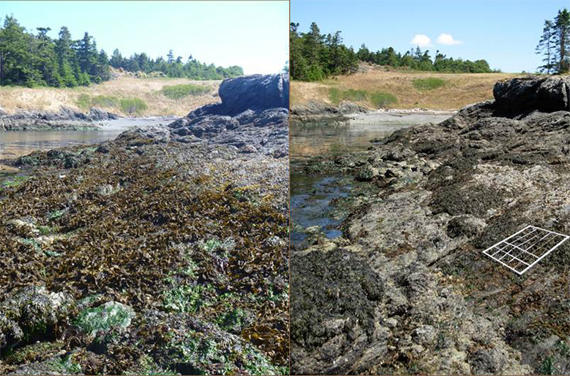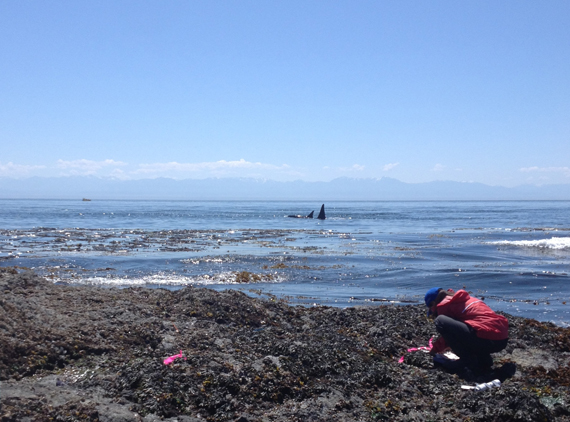Love of Kelp
by Jennifer Burnaford, Assistant Professor of Biology, California State University Fullerton
I love kelp, and I am particularly fond of the intertidal kelp Saccharina sessilis (formerly Hedophyllum sessile: commonly known as the sea cabbage). Saccharina’s unique morphology (multiple thick blades emerging directly from a single root-like holdfast) creates a stable canopy over a rocky bench during low tide. A single blade blocks 97% of ambient sunlight (Burnaford and Vasquez 2008), and the area under the canopy can be 13°C cooler than open rock surfaces (Burnaford 2004). Many intertidal animals rely on this cool dark environment for protection from harsh low tide conditions (e.g. ochre sea star Pisaster ochraceus [Burnaford and Vasquez 2008] and black chiton Katharina tunicata [Burnaford 2004, Burnaford et al. 2014]). The kelp also affects other seaweeds, as only select species can tolerate the low light levels under the canopy (Dayton 1975). Saccharina truly lives up to the label ‘foundation species’ (Dayton 1972), because it structures the entire community.
 Dramatic change in the kelp canopy from a year of high cover to a year of low cover
Dramatic change in the kelp canopy from a year of high cover to a year of low cover
Credit: Jennifer Burnaford
Over the past 17 years, I have watched the abundance of Saccharina in the San Juans shift dramatically, covering 70% of the rock surface in the late 1990s but less than 25% of the rock surface in the mid 2000s. What controls the abundance of Saccharina? Drying out and heating up during low tide severely reduce the seaweed’s capacity to photosynthesize (and thus make sugars for energy: Burnaford et al. 2014). The longer the exposure to air (and wind, and sun), the more exaggerated this energy deficit becomes. And it turns out that low tide exposure time fluctuates dramatically on a decadal scale: from a total of 344 hours in 12 months in 1998 to 818 hours over 12 months in 2007 (Burnaford et al. 2014). This is a consequence of the 18.6 year cycle of lunar declination (the angle of the plane of the moon’s orbit relative to the plane of the earth’s equator: Denny and Paine 1998, Burnaford et al. 2014). The extent of the Saccharina canopy on the rocky shore is tightly linked to the amount of emersion time in the previous 12 months (Burnaford et al. 2014). Detecting this long-term pattern was only possible because of the availability of study sites free from human interference (e.g. collecting or trampling) so that we could pull out the long-term signature of this lunar cycle on Saccharina and subsequently on the rest of the community.
 REU student Vy Nguyen in the field. Who cares about orcas when there is kelp to study!
REU student Vy Nguyen in the field. Who cares about orcas when there is kelp to study!
Credit: Julie Pineda
My work has greatly benefitted from collaborations with colleagues and undergraduate scholars throughout the years: 16 undergraduates from 6 different institutions have conducted summer research projects on this system since 1999. Currently, fellow FHL alumna Dr. Scottie Henderson and I are working together to quantify the effects of specific low tide stressors on Saccharina. In 2013, our REU students Vy Nguyen and Julie Pineda found that desiccation (drying out) has strong effects on not only Saccharina’s photosynthetic health but also on concentrations of defensive chemicals, which affects the quality of the kelp as food for herbivores. These student projects launched a new collaboration with chemical ecologist Kathy Van Alstyne, focused on examining the suite of chemical changes that occur in the kelp during low tide. In summer 2015, CSU Fullerton undergraduates Blake Miyamoto and Melanie Espino-Canche worked with us to better understand these changes in kelp chemistry and the feeding responses of herbivores to healthy and stressed Saccharina. Collectively, these studies help us to piece together a complex network of interactions: between the environment and individual kelps, between individual kelps and their consumers, and between the kelp population and the rest of the community. Understanding how these pieces fit together is essential to understanding the ecological consequences of a changing climate. This love of kelp has led us in directions I never considered when I started working on this system, and will keep us occupied for years to come.
Citations (* indicates FHL Blinks Fellow undergraduate co-author)
Burnaford, J.L. 2004. Habitat modification and refuge from sublethal stress drive a marine plant-herbivore association. Ecology 85: 2837-2849
Burnaford, J.L., and M. Vasquez*. 2008. Solar radiation plays a role in habitat selection by the sea star Pisaster
ochraceus. Marine Ecology Progress Series 368: 177-187
Burnaford, J.L., K.J.Nielsen, and S.L. Williams. 2014. Celestial mechanics affects emersion time and cover patterns of an
ecosystem engineer, the intertidal kelp Saccharina sessilis. Marine Ecology Progress Series 509: 127-136
Dayton, P.K. 1972. Toward an understanding of community resilience and the potential effects of enrichments to the
benthos at McMurdo Sound, Antarctica. Pages 81–95 in B. C. Parker, editor. Proceedings of the Colloquium on Conservation Problems in Antarctica. Allen Press, Lawrence, Kansas, USA.
Dayton, P.K. 1975. Experimental evaluation of ecological dominance in a rocky intertidal algal community. Ecological Monographs 45:137–159
Denny, M.W., and R.T. Paine. 1998. Celestial mechanics, sea-level changes, and intertidal ecology. Biological Bulletin
194: 108−115



